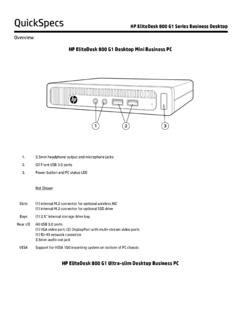Transcription of LifeSize Video Conferencing Systems User Guide
1 LifeSize Video Conferencing Systems User Guide University of California, Davis Information and Educational Technology Office of the Vice Provost LifeSize Video Communications System Quick-Start Guide Making a Video Call Calling a Recently Dialed Site 1. From the main menu, navigate through the Redial list in the center of the screen using the arrow buttons on the remote. The list will contain the last 10 successful connections. 2. If the party that you are calling is on this list, scroll down to their name and click OK on the remote to connect. Calling a Site from the Directory 1. If the party you are looking for is not on the Redial list (see above), you may find the address in the Directory.
2 To access the Directory go to the main menu (because the buttons on the remote do different things in different menus/screens), THEN press the yellow triangle on the remote. This gets you to the Directory. 2. Scroll through entries in the directory using the arrow keys on the remote until the desired address/connection is highlighted. Press the OK button to connect to that address. 3. The system will dial the other party. 4. To hang up, press the OK button again. Calling a New Site: 1. Using the arrows on the remote, select the Video Call' image. 2. Type in the IP address ( ) of the party you are calling. 3.
3 Press OK on the remote to select the IP address. 4. Press the Call button at the top of the remote to place your call. 5. The system will dial the other party. 6. To hang up, press the OK button again. 7. Note: This IP address (if the call is successful) will be added to the redial list temporarily. If you want to save this IP address for future calls, you will need to enter it into the Address Book. Making a Voice Call 1. Make sure the phone cord has been properly plugged into the codec AND phone jack. 2. If the telephone number is not on the Redial list or in the Directory, then using the remote's arrow keys, select the Voice Call' image from the main menu and press OK.
4 3. Enter the telephone number using the number keys on the remote, and then press the OK. button. 4. Press the Call button at the top of the remote to place your call. 5. To disconnect, press the OK button. Adding Another Location to the Call Once You Are Already on a Call ( Video or Voice): 1. Navigate away from the screen showing the current participants by pressing the orange back/. cancel button on the remote. 2. Select Video Call' (or Voice Call') on the menu and press OK on the remote. The Call Manager screen will appear. 2. 3. Select Add Call' on the menu and press OK on the remote. You will be returned to the Main Menu.
5 4. Follow steps for calling a recently dialed site or a new site (above), as appropriate. 5. To add additional participants, repeat the above process. Up to six participants may participate at one time, including you. A laptop counts as one participant. Adding/Accepting Incoming Calls: 1. For the first call ( when you are not already connected with another site), the system will automatically answer. When the call has connected, press the mute/unmute button on the microphone/speaker system to allow audio . 2. For additional calls once you are already connected with another site, select the Answer Call . option that will appear at the bottom of the screen and press OK.
6 3. To disconnect, select the Hang-Up option at the bottom of the screen and press OK. Adding a Video Presentation to a Meeting: 1. Connect a VGA cable from the codec to the VGA output on your laptop. 2. Make sure that your laptop is set to display Video out from its VGA port. 3. Test your computer's connection by pressing the Near' button on the remote; the Primary Input Menu' will appear. Your desktop or presentation should appear in the PC display window. 4. Once the videoconferencing units of the other participants have connected, begin your presentation by pressing the green button. 5. When the presentation is complete, press the green button again to exit.
7 3. Table of Contents System Components .. 4-5. Remote Control Diagram .. 6. System Set-Up .. 7-9. Powering Up the System .. 10. Taking Down the System .. 11-12. Transporting the System .. 13. How to Make a Video Call .. 14. To a previous site To a new site How to Make a Voice Call .. 15. Adding another call Adding incoming calls How to Add a Video Presentation .. 16. Changing the primary display source Using the Directory .. 17-18. Accessing the Directory Adding entries Removing entries Frequently Asked Questions .. 19. 4. LifeSize Video Communications System Components HD Camera: LifeSize high definition Video communications system.
8 LifeSize Phone: A high definition audio Conferencing speakerphone with 16 microphones in a circular array to capture sound is also integrated with the LifeSize Video communication system. It doubles as the microphone for the Video system. LifeSize Codec : The codec unit compresses outgoing Video , audio , and data content, and then transmits this information to the remote caller. It also decompresses incoming transmissions. (Image does not represent actual unit.). LifeSize Remote Control: Remote control provides wireless control of all LifeSize Video communications system functions. It enables you to navigate the user interface, place and receive calls, and control the camera.
9 5. LifeSize Video Conferencing Remote Control Diagram 6. 7. LifeSize Video Communications System Setup 1. Position the case so that the JELCO logo is facing the front. 2. Lock one wheel at the bottom of the case to prevent movement. (You may need to get behind the unit to do so.). 3. Open the four case locks by pulling the lever down and twisting it counter-clockwise. Once the lock is open, pull the locking tab towards you. Repeat these steps for all four locks. 4. Standing in front of the unit, locate the camera (stored upside down) in the far right corner of the case. 8. 5. Connect the white firewire to the camera before mounting it.
10 6. Mount the camera on top of the frame facing the front. Secure the camera with the screw from under the base plate. Remove the lense cap. 7. Pull the release handle behind the monitor; the plasma screen and frame will slowly rise. 8. Plug the LifeSize unit and monitor power cords into the power strip. There is an ON switch located at the top of the power strip. 9. 9. Plug in the phone unit and network cable to the codec unit located behind the monitor. The end of the phone unit's cable is orange. The network cable is blue at both ends. 10. Attach the dress cloth and clips (if desired). 11. Make sure everything is setup and plugged in before clicking the ON switch on the power strip.





